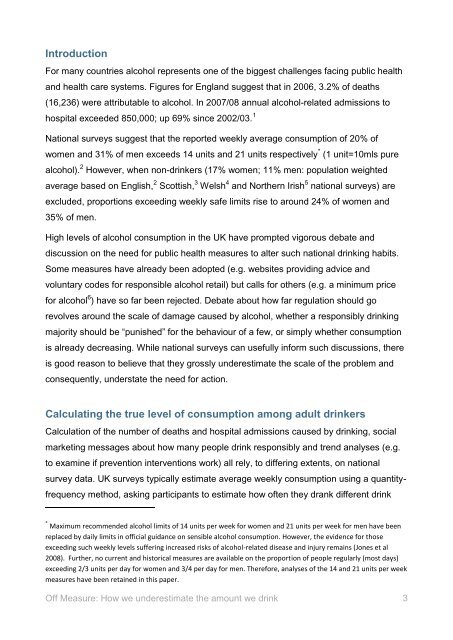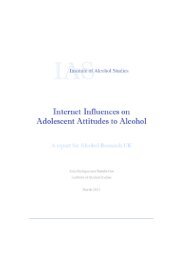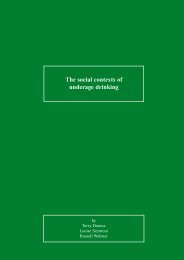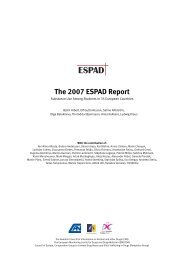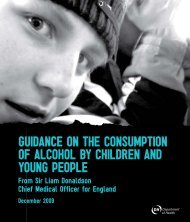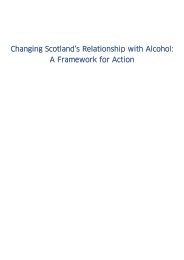Off Measure: How we underestimate the amount ... - Alcohol Concern
Off Measure: How we underestimate the amount ... - Alcohol Concern
Off Measure: How we underestimate the amount ... - Alcohol Concern
You also want an ePaper? Increase the reach of your titles
YUMPU automatically turns print PDFs into web optimized ePapers that Google loves.
IntroductionFor many countries alcohol represents one of <strong>the</strong> biggest challenges facing public healthand health care systems. Figures for England suggest that in 2006, 3.2% of deaths(16,236) <strong>we</strong>re attributable to alcohol. In 2007/08 annual alcohol-related admissions tohospital exceeded 850,000; up 69% since 2002/03. 1National surveys suggest that <strong>the</strong> reported <strong>we</strong>ekly average consumption of 20% ofwomen and 31% of men exceeds 14 units and 21 units respectively * (1 unit=10mls purealcohol). 2 <strong>How</strong>ever, when non-drinkers (17% women; 11% men: population <strong>we</strong>ightedaverage based on English, 2 Scottish, 3 Welsh 4 and Nor<strong>the</strong>rn Irish 5 national surveys) areexcluded, proportions exceeding <strong>we</strong>ekly safe limits rise to around 24% of women and35% of men.High levels of alcohol consumption in <strong>the</strong> UK have prompted vigorous debate anddiscussion on <strong>the</strong> need for public health measures to alter such national drinking habits.Some measures have already been adopted (e.g. <strong>we</strong>bsites providing advice andvoluntary codes for responsible alcohol retail) but calls for o<strong>the</strong>rs (e.g. a minimum pricefor alcohol 6 ) have so far been rejected. Debate about how far regulation should gorevolves around <strong>the</strong> scale of damage caused by alcohol, whe<strong>the</strong>r a responsibly drinkingmajority should be “punished” for <strong>the</strong> behaviour of a few, or simply whe<strong>the</strong>r consumptionis already decreasing. While national surveys can usefully inform such discussions, <strong>the</strong>reis good reason to believe that <strong>the</strong>y grossly <strong>underestimate</strong> <strong>the</strong> scale of <strong>the</strong> problem andconsequently, understate <strong>the</strong> need for action.Calculating <strong>the</strong> true level of consumption among adult drinkersCalculation of <strong>the</strong> number of deaths and hospital admissions caused by drinking, socialmarketing messages about how many people drink responsibly and trend analyses (e.g.to examine if prevention interventions work) all rely, to differing extents, on nationalsurvey data. UK surveys typically estimate average <strong>we</strong>ekly consumption using a quantityfrequencymethod, asking participants to estimate how often <strong>the</strong>y drank different drink* Maximum recommended alcohol limits of 14 units per <strong>we</strong>ek for women and 21 units per <strong>we</strong>ek for men have beenreplaced by daily limits in official guidance on sensible alcohol consumption. <strong>How</strong>ever, <strong>the</strong> evidence for thoseexceeding such <strong>we</strong>ekly levels suffering increased risks of alcohol-related disease and injury remains (Jones et al2008). Fur<strong>the</strong>r, no current and historical measures are available on <strong>the</strong> proportion of people regularly (most days)exceeding 2/3 units per day for women and 3/4 per day for men. Therefore, analyses of <strong>the</strong> 14 and 21 units per <strong>we</strong>ekmeasures have been retained in this paper.<strong>Off</strong> <strong>Measure</strong>: <strong>How</strong> <strong>we</strong> <strong>underestimate</strong> <strong>the</strong> <strong>amount</strong> <strong>we</strong> drink 3


